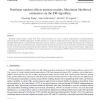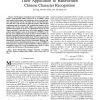1826 search results - page 36 / 366 » Using Random Forests in the Structured Language Model |
DOCENG
2003
ACM
14 years 1 months ago
2003
ACM
This paper reports some experiments in using SVG (Scalable Vector Graphics), rather than the browser default of (X)HTML/CSS, as a potential Web-based rendering technology, in an a...
CSDA
2007
13 years 8 months ago
2007
Nonlinear random effects models with finite mixture structures are used to identify polymorphism in pharmacokinetic/ pharmacodynamic (PK/PD) phenotypes. An EM algorithm for maxim...
DEBU
2007
13 years 8 months ago
2007
An indexing model is the heart of an Information Retrieval (IR) system. Data structures such as term based inverted indices have proved to be very effective for IR using vector sp...
CIKM
2008
Springer
13 years 10 months ago
2008
Springer
We address the problem of academic conference homepage understanding for the Semantic Web. This problem consists of three labeling tasks - labeling conference function pages, func...
TFS
2008
2008
Type-2 Fuzzy Markov Random Fields and Their Application to Handwritten Chinese Character Recognition
13 years 8 months ago
In this paper, we integrate type-2 (T2) fuzzy sets with Markov random fields (MRFs) referred to as T2 FMRFs, which may handle both fuzziness and randomness in the structural patter...


